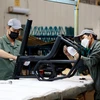Domestic sea transportation businesses are struggling to win market share amid fierce competition of the world’s new generation fleets.
Despite abundant flows of commodities, the domestic sea transport shipping fleet is hamstrung by its old vessels with out-of-date technology.
Given that, the Vietnam Maritime Administration has suggested policies to rescue the shipping fleet.
Old-fashioned vessels
Statistics by the Vietnam Maritime Administration showed that Vietnam has 1,586 ships (as of June 1), including 1,128 being cargo ships.
As of June, the total volume of cargo through Vietnam’s seaports was estimated at 308.7 million tonnes, up 21 percent compared with the same period of 2018.
In regard to transport market share, transportation service businesses can handle 100 percent of the domestic market share except for specialised ships such as cement and liquefied natural gas carriers. Meanwhile, they can only handle a tenth of export-import market share.
According to the Vietnam Maritime Administration, domestic marine transportation has shrunk and no sign of recovery has been seen.
Pointing to the US – China trade war, a representative from the bureau said it has led to sharp declines in global exports and imports of goods. Not surprisingly, the shortage of goods triggers the redundancy of a large amount of vessels.
In addition, oil price fluctuations have also harmed the efficacy of transportation businesses.
This is also because of the long-term habit of many cargo owners who often buy goods based on the CIF (Cost, Insurance and Freight) method or sell goods using the FOB (Free on Board) method. Therefore, Vietnamese businesses have lost goods carriage rights and have to use ships firms nominated by international clients.
Meanwhile, some projects such as coal imports are up for international auction, making it harder for domestic fleets to win contracts, said the official.
This is also because of old vessels with more than 15 years of operation and out-of-date technologies.
Further, domestic sea transport firms have to try and upgrade their fleet capacity in the context of financial difficulties including high interest rates and large debts.
Buoys needed for domestic fleet
With an unstable source of cargo and short-term contracts, the Vietnam Maritime Administration recommended domestic ship owners not build new ships until stable flows of cargo and long-term contracts are signed with clients.
It seems to be the fact that sea transport firms have not received any assistance from the Government while they are almost incapable of building large weight ships which requires a huge amount of money.
As a result, the Vietnam Maritime Administration submitted a proposal to implement domestic auctions to offer more chances for domestic firms to win a contract.
In international auctions, it is recommended that cargo owners grant 30 percent of freight to domestic fleets under contracts of at least three years.
The Ministry of Transport said that sea transport businesses are put on the list of small and medium-sized enterprises enjoying preferential enterprise income tax of 10 percent during 15 years, added value tax reduction for domestic transport in three years, and tax free for imports of spare parts and repairing equipment that Vietnam has not manufactured.
In terms of investment capital to upgrade the fleets, the Ministry recommended the State Bank of Vietnam scrutinise lending sea transport firms from the development and investment fund with preferential interest rates.
Statistics from the Vietnam Maritime Administration show that in the first half of this year, Vietnams ports handled 308.8 million tonnes of goods, up 13 percent compared to the same period in 2018. Notably, the volume of container cargo reached 9.1 million twenty-foot equivalent unit (TEUs), up 3 percent year-on-year.-VNA





















